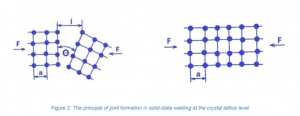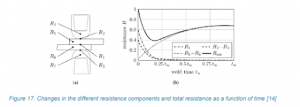Lesson 2: WELDING II – welding processes, solid state welding processes, and welding processes using both fusion and mechanical stress
In this lesson, we delve deeper into various welding processes, focusing on solid-state welding techniques and processes that combine fusion and mechanical stress.
- SOLID-STATE WELDING PROCESSES
1.1. Cold Welding
- Cold welding involves creating a joint using a pressing tool below the recrystallization temperature of the material.
- Only metals and alloys with high ductility can be cold-welded, as significant ductile deformation is required for a proper bond.
- Surface contamination, especially oxides, can affect joint quality, so thorough cleaning of the surfaces is crucial.
- Higher levels of ductile deformation can remove surface contaminants, reducing the importance of cleaning.
- A variant of cold welding uses shockwaves generated by chemical energy (explosion welding) or magnetic fields (magnetic pulse welding) to create joints at high speeds.
1.2. Welding Processes Using the Friction Principle
- Friction welding processes rely on the heat generated by friction during relative displacement and the mechanical work to create a bond.
- Frictional heat raises surface temperatures and increases material plasticity, while pressure causes surface deformation and flash formation, removing contaminants.
- Friction welding includes variations like friction stir welding and ultrasonic welding.
- Friction stir welding employs a rotating tool with a pin to create heat and mechanically mix materials.
- Ultrasonic welding uses rapid changes in magnetic fields to generate ultrasound for welding.
- These processes are ideal for welding metals that are brittle in their cold state.
1.3. Diffusion Welding
- Diffusion welding is a unique solid-state welding process where the welded joint forms through diffusion between material parts.
- Special conditions, often involving temperatures near the solidus, are required for diffusion to occur.
- Diffusion welding typically involves longer welding times.

- WELDING PROCESSES USING BOTH FUSION AND MECHANICAL STRESS
2.1. Resistance Welding Processes
- Resistance welding relies on Joule heat generated by electric current resistance for welding.
- Processes include direct current resistance welds and induction welding.
- Direct current resistance welds involve high initial contact resistance that reduces as the pieces deform and melt.
- Resistance spot welding, resistance seam welding, resistance projection welding, and foil seam welding are variations of this process.
- Induction welding uses inductors to create a changing magnetic field that generates eddy currents, providing Joule heat for welding.
2.2. Pressure Arc Welds
- In pressure arc welding, surfaces are melted by an arc, and pressure is applied to create the joint.
- Two variations include rotating arc welding and stud arc welding.
- Rotating arc welding is used for butt welding of pipes, where the arc rotates around the tube to uniformly melt surfaces.
- Stud arc welding is suitable for welding studs of different sizes and lengths using either a transformer or a capacitor bank.
- Arc ignition methods include arc pulling and ignition tips.
- Protective measures like gases, welding flux, or ceramic rings may be used for larger studs.

Conclusion:
- Solid-state welding processes enable atom-to-atom bonding without melting workpieces, relying on mechanical work and plastic deformation.
- Cold welding is suitable for highly ductile materials but requires meticulous surface preparation to achieve strong bonds.
- Friction-based welding methods, including friction stir welding and ultrasonic welding, offer versatile options for joining various materials.
- Diffusion welding, a rare process, relies on atomic diffusion at temperatures near the solidus for bonding.
- Welding processes combining fusion and mechanical stress, such as resistance and pressure arc welding, provide efficient methods for joining metals and alloys.
These welding processes offer a diverse toolkit for engineers and welders to choose from, ensuring the creation of robust and dependable welds across different industries and applications.